Disciplinary Warning Letter
Subject: Disciplinary Warning
Dear [Employee's Name],
I hope this letter finds you well. The purpose of this communication is to bring to your attention a matter of concern regarding your recent performance and behavior at [Company Name]. We take pride in maintaining a positive work environment that fosters productivity, teamwork, and professionalism. However, it has come to our attention that your actions have deviated from these expected standards.
I would like to highlight the following instances where your conduct has been found to be in violation of our company policies and expectations:
1. [Provide a detailed description of the first incident, including date, time, location, and the specific policy violated.]
2. [Provide a detailed description of the second incident, including date, time, location, and the specific policy violated.]
3. [If applicable, provide additional incidents in a similar format.]
It is crucial to emphasize that such behavior not only disrupts the work environment but also negatively impacts team morale and hinders our overall performance. We expect all employees, including yourself, to adhere to the company's code of conduct and maintain professional conduct at all times.
As a result of the aforementioned incidents, the following disciplinary actions will be implemented:
1. Formal written warning: This letter serves as an official written warning regarding your conduct. It will be placed in your personnel file, and a copy will be provided to you for your records.
2. Performance improvement plan: You will be required to meet with your supervisor to develop a performance improvement plan. This plan will outline specific expectations, goals, and a timeline for improvement. Regular progress meetings will be scheduled to monitor your progress.
3. Training or counseling: Depending on the nature of the violations, you may be required to attend additional training sessions or counseling sessions to address any underlying issues and develop the necessary skills to improve your conduct.
Please be aware that any further violations of company policies or unsatisfactory performance may result in more severe disciplinary actions, up to and including suspension or termination of employment.
I strongly encourage you to reflect on your actions and take this warning seriously. If you have any concerns or questions regarding this matter, please do not hesitate to discuss them with your supervisor or the Human Resources department.
We believe in your potential to rectify these concerns and regain a positive standing within the company. We hope that this warning serves as a turning point for improvement and that we can count on your commitment to upholding the company's values and standards.
Thank you for your attention to this matter.
Sincerely,
[Your Name]
[Your Position]
[Company Name]
First Disciplinary Warning Letter
Subject: First Warning for Misconduct
Dear Mr. Smith,
This letter serves as a formal warning regarding your recent behavior in the workplace on September 20th. It has been observed that you repeatedly arrived late without notifying your supervisor.
Please consider this letter as a first warning. Continued tardiness may lead to further disciplinary actions including suspension or termination. We encourage you to take immediate corrective action.
Sincerely,
[Your Name]
[Position]
[Company Name]
Serious Disciplinary Warning Letter
Subject: Serious Warning Regarding Conduct
Dear Ms. Johnson,
Following our discussion on October 5th regarding inappropriate behavior in the office, this letter serves as a formal serious warning. Your actions were unprofessional and violated company policies.
Please take immediate corrective measures. Any repetition of such behavior may result in suspension or termination. Your acknowledgment of this warning is required.
Sincerely,
[Your Name]
[Position]
[Company Name]
Informal Warning Letter Email
Subject: Friendly Reminder Regarding Work Behavior
Hi Tom,
I wanted to bring to your attention that we noticed a few issues regarding missed deadlines last week. While this is not severe, it’s important to improve on punctuality and task completion.
Please treat this email as a gentle reminder to maintain standards. Let’s discuss any obstacles you may be facing during our next team meeting.
Best,
[Your Name]
Written Warning for Repeated Policy Violation
Subject: Written Warning for Repeated Policy Breaches
Dear Mr. Lee,
This letter is to formally address the repeated violation of company policies concerning internet usage during work hours. Despite verbal reminders, the behavior persists.
This serves as a written warning and any future violation will result in stricter disciplinary action, up to and including termination. You are required to acknowledge receipt of this warning.
Sincerely,
[Your Name]
[HR Manager]
[Company Name]
Final Disciplinary Warning Letter
Subject: Final Warning
Dear Ms. Patel,
This letter constitutes a final warning regarding your unprofessional conduct observed over the past three months. Prior warnings have been issued on August 1st and September 15th.
Any further incident will lead to immediate termination. Please treat this letter with the utmost seriousness and take corrective action immediately.
Sincerely,
[Your Name]
[Position]
[Company Name]
Disciplinary Warning Letter for Attendance Issues
Subject: Warning for Attendance Irregularities
Dear Mr. Ahmed,
This letter is to formally warn you regarding your frequent absenteeism from work. Attendance records indicate multiple unapproved absences over the last month.
Please ensure that you comply with company attendance policies moving forward. Failure to do so may result in further disciplinary measures.
Regards,
[Your Name]
[Supervisor]
Professional Email Warning Letter
Subject: Performance and Conduct Warning
Dear Sarah,
I am writing to address concerns about your recent performance and adherence to deadlines. While your contributions are valued, repeated delays are affecting team productivity.
Please treat this as a formal warning to improve performance immediately. We are available to discuss support or adjustments that may help meet expectations.
Best regards,
[Your Name]
[Position]
[Company Name]
Disciplinary Warning Letter for Misconduct
Subject: Misconduct Warning
Dear Mr. Thompson,
This letter serves to notify you of unacceptable behavior witnessed in the workplace on October 3rd. The actions reported are contrary to company policies.
Immediate improvement is required. Any recurrence will lead to more severe disciplinary actions, potentially including termination.
Sincerely,
[Your Name]
[HR Department]
[Company Name]
What is a Disciplinary Warning Letter and Why It Is Important
A disciplinary warning letter is a formal document issued by an employer to address an employee’s misconduct, policy violation, or underperformance.
It is important because it:
- Clearly communicates unacceptable behavior.
- Provides documentation for HR and legal purposes.
- Serves as a formal step before more severe disciplinary actions.
- Helps employees understand expectations and consequences.
Who Should Send a Disciplinary Warning Letter
- Human Resources personnel for official warnings.
- Immediate supervisors or managers for performance-related warnings.
- Department heads in consultation with HR for serious misconduct.
- Company executives for high-level infractions.
Whom Should the Disciplinary Warning Letter Be Addressed To
- The employee who committed the infraction.
- In cases of repeated violations, HR should be cc’d.
- Supervisors and department heads may receive copies for record-keeping.
- For unionized workplaces, union representatives may also be included.
When to Issue a Disciplinary Warning Letter
- After verbal warnings have been ignored.
- When serious misconduct occurs.
- In cases of repeated policy violations.
- When poor performance or behavior affects team productivity.
- Prior to formal disciplinary actions like suspension or termination.
How to Write and Send a Disciplinary Warning Letter
- Begin with a clear subject line indicating warning type.
- Address the employee formally.
- Describe the incident or behavior clearly with dates and evidence.
- Mention prior verbal warnings if applicable.
- Specify expected corrective actions and timeline.
- Outline consequences of repeated violations.
- Send via official channels: email for speed, printed copy for HR records.
Elements and Structure of a Disciplinary Warning Letter
- Subject: Clear statement of warning purpose.
- Salutation: Employee’s name and title.
- Introduction: Reference to the incident or behavior.
- Details of misconduct: Dates, events, and evidence.
- Prior warnings: Mention previous steps taken.
- Corrective action: Specific expectations and deadlines.
- Consequences: Future disciplinary measures.
- Closing: Professional sign-off and HR contact.
- Acknowledgment: Space for employee signature.
Common Mistakes in Disciplinary Warning Letters
- Being vague or unclear about the misconduct.
- Using emotional or accusatory language.
- Failing to reference prior warnings.
- Not specifying corrective actions or consequences.
- Sending without proper documentation or HR review.
Tips for Writing an Effective Disciplinary Warning Letter
- Be concise, objective, and professional.
- Provide evidence and dates of incidents.
- Use neutral language to avoid conflict escalation.
- Clearly outline expectations and consequences.
- Keep copies for HR and employee records.
After Sending a Disciplinary Warning Letter: Follow-up Actions
- Ensure employee acknowledges receipt.
- Monitor performance and behavior for improvement.
- Document follow-up meetings or progress reports.
- Take additional disciplinary action if non-compliance continues.
- Provide support or resources for improvement if needed.
Advantages and Disadvantages of Disciplinary Warning Letters
Pros:
- Creates official documentation for HR and legal purposes.
- Provides employees with a clear opportunity to correct behavior.
- Supports fairness and transparency in disciplinary processes.
Cons:
- May strain employer-employee relationships.
- Risk of legal challenges if not properly documented.
- Can impact team morale if perceived as unfair or biased.
Requirements and Prerequisites Before Issuing a Disciplinary Warning Letter
- Accurate records of employee behavior or performance issues.
- Documentation of prior verbal warnings.
- Knowledge of company policies and procedures.
- Consultation with HR for compliance with labor laws.
- Understanding of potential consequences for the employee.
Formatting Guidelines for a Disciplinary Warning Letter
- Maintain formal, professional tone.
- Keep the letter clear, concise, and one to two pages long.
- Include employee name, dates, and incident details.
- Use headers or bullet points for clarity if needed.
- Ensure official signatures from HR or manager.

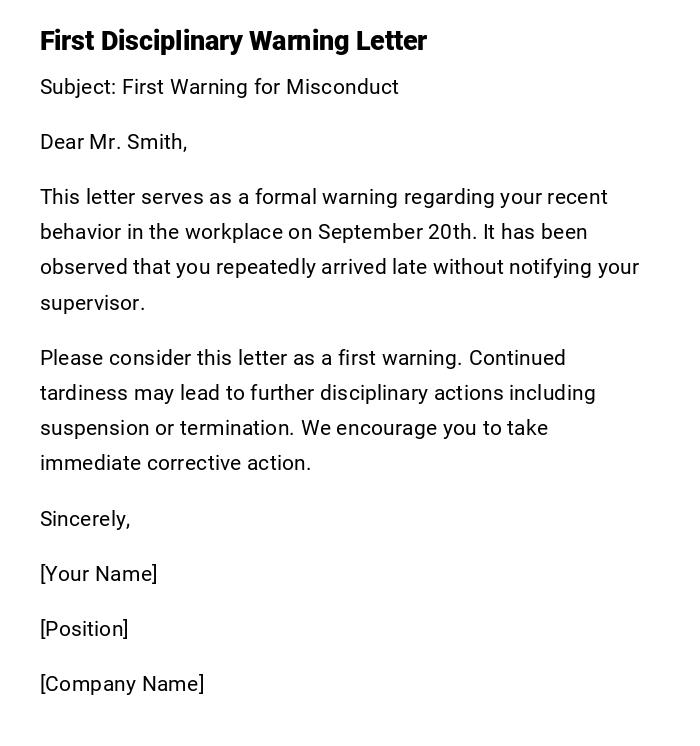
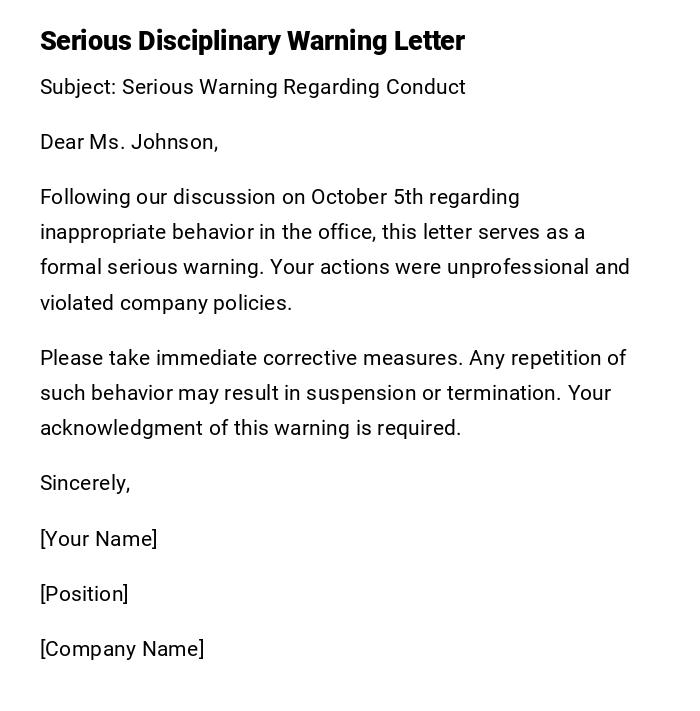
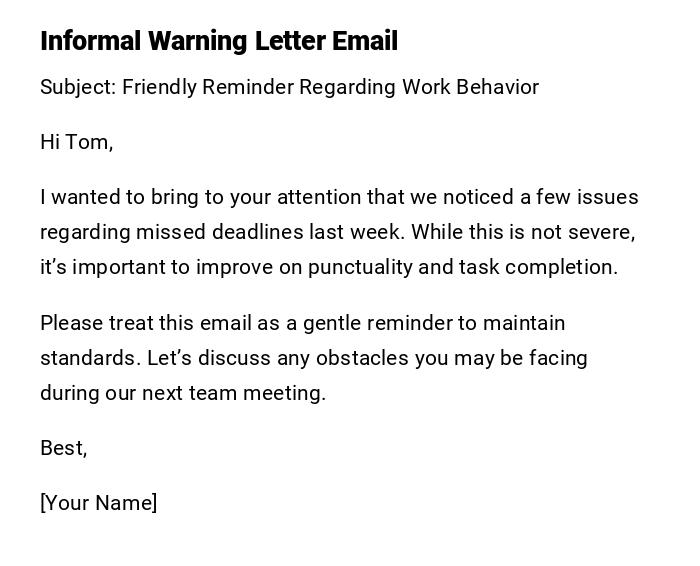
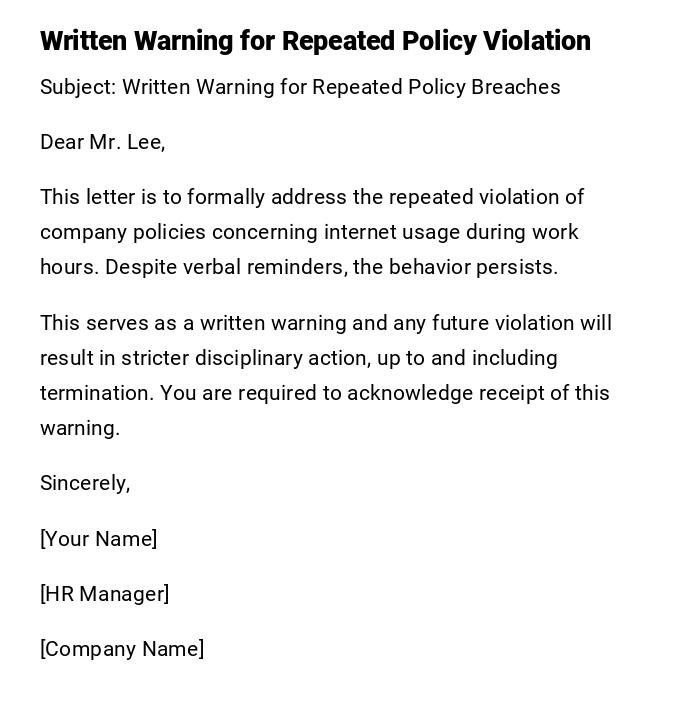
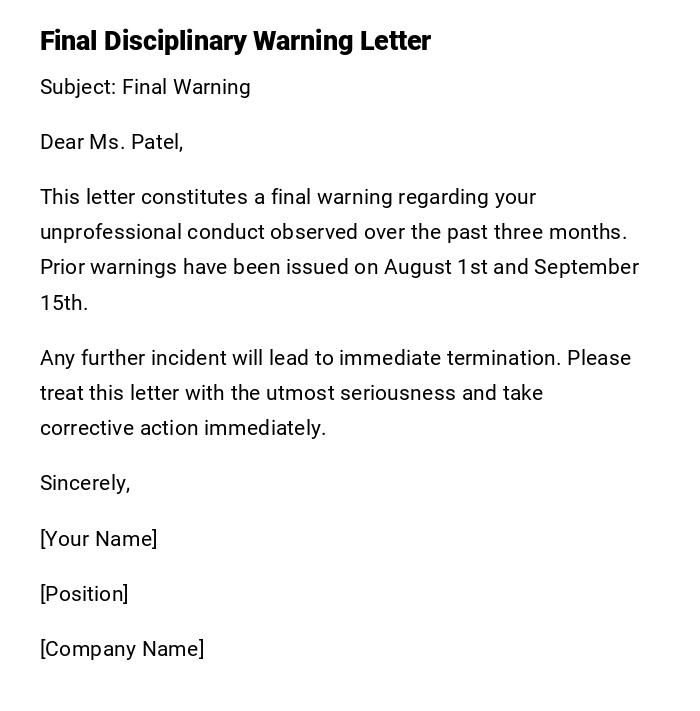
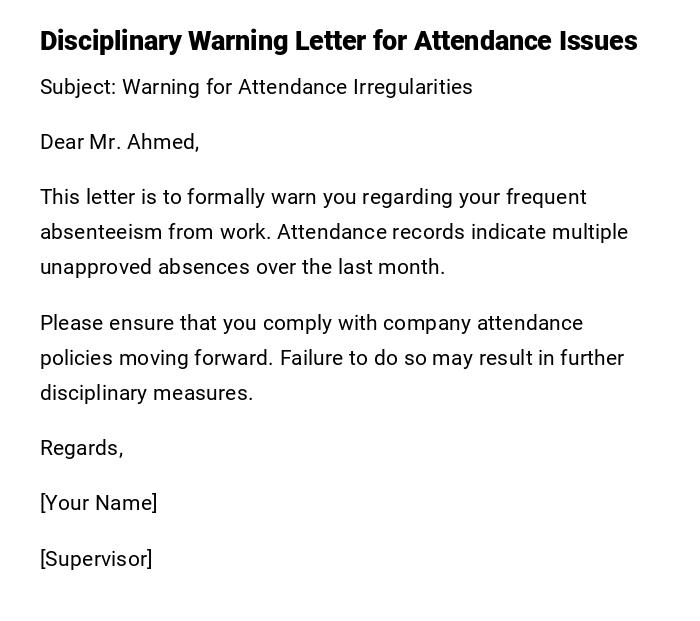
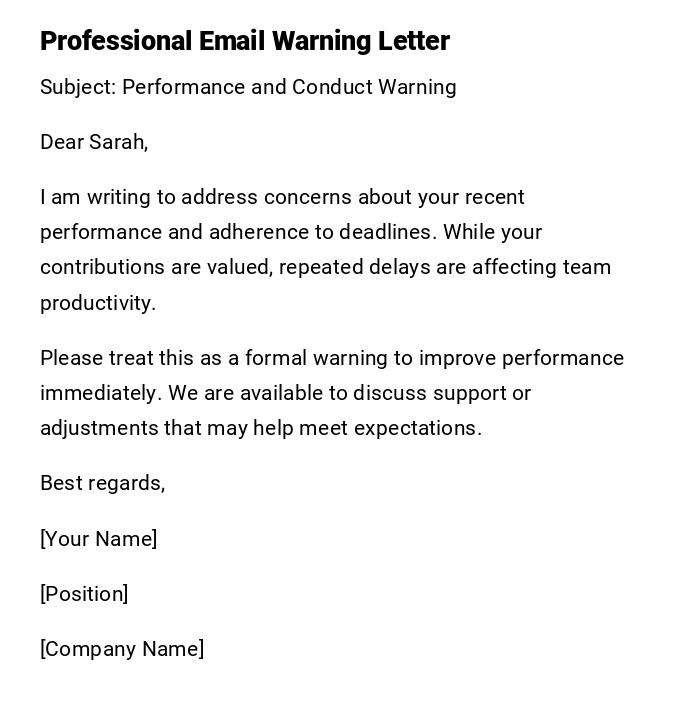
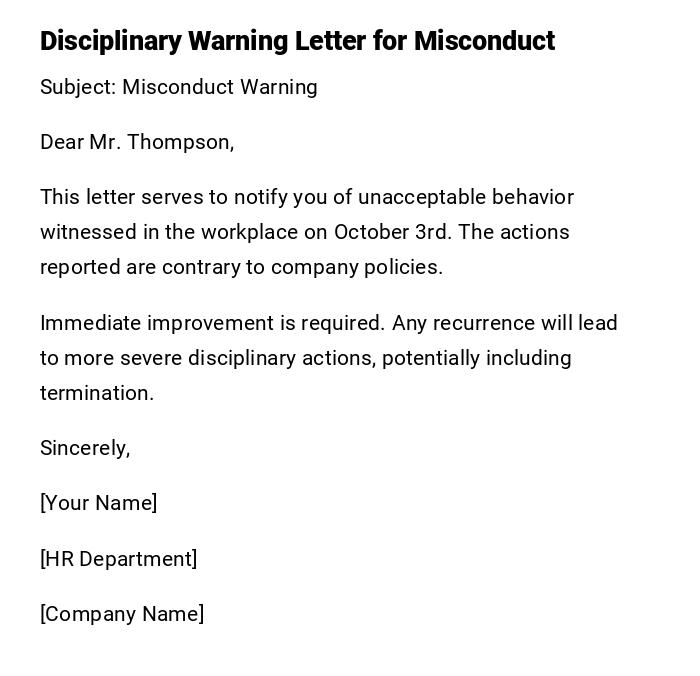

 Download Word Doc
Download Word Doc
 Download PDF
Download PDF